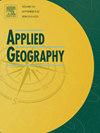Unveiling the Spatio-Temporal Patterns and mechanisms of poverty incidence in Southwest China through multi-sourced data and interpretable machine learning
IF 4
2区 地球科学
Q1 GEOGRAPHY
引用次数: 0
Abstract
China's poverty alleviation practice stands out globally, yet illuminatingly decoding its complex process remains challenging due to data and method fragmentation. This study proposed an integrated analytical framework combining multi-source data fusion, ensemble learning, and interpretable machine learning. By integrating multi-dimensional socioeconomic survey (SES) data with spatiotemporally continuous nighttime light (NTL) observations, the framework enables robust poverty prediction and mechanistic insights in data-rich and data-scarce contexts. The method was applied to examine poverty reduction dynamics in Yunnan-Guizhou-Guangxi area (YGGA) of Southwest China. Across 328 county-level units, the average poverty incidence markedly decreased from 33.38% to 12.42% (2000–2019), characterized by three phases: widespread high poverty (2000–2005), uneven regional improvement (2006–2012), and transformative poverty reduction (2013–2019). Spatio-temporal analysis uncovered the transformation from highly clustered poverty to a more dispersed distribution. Through interpretable machine learning, the study analyzed 24 driving factors in three categories. While economic & demographic indicators became increasingly dominant, the persistent influence of geographical & environmental, and social & infrastructure indicators underscored the necessity for an integrated approach to poverty governance. This study provided insights for China's post-poverty alleviation era while contributing towards inclusive growth within global sustainable development framework.
求助全文
约1分钟内获得全文
求助全文
来源期刊

Applied Geography
GEOGRAPHY-
CiteScore
8.00
自引率
2.00%
发文量
134
期刊介绍:
Applied Geography is a journal devoted to the publication of research which utilizes geographic approaches (human, physical, nature-society and GIScience) to resolve human problems that have a spatial dimension. These problems may be related to the assessment, management and allocation of the world physical and/or human resources. The underlying rationale of the journal is that only through a clear understanding of the relevant societal, physical, and coupled natural-humans systems can we resolve such problems. Papers are invited on any theme involving the application of geographical theory and methodology in the resolution of human problems.
 求助内容:
求助内容: 应助结果提醒方式:
应助结果提醒方式:


